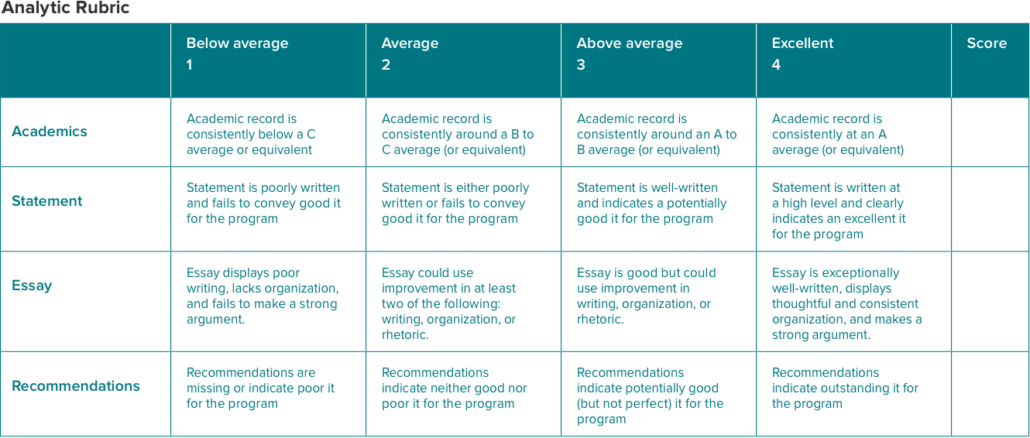Last month, we debuted the first portion of our take on holistic admissions.
To recap:
Modern holistic admissions takes a panoramic view of each applicant for higher education. Practitioners look to the quality of the applicant as a whole, rather than focusing solely on their quantitative achievements.
The ultimate objective is to help level the higher ed playing field, expanding its reach to include students from underserved communities and underrepresented cultures while adding to the depth and breadth of student populations by seeking out a unique combination of talents, attributes, and life experiences.
Typical holistic admissions applications will weigh various components such as:
- extracurricular activity
- demographics/location
- personal essay or statement
- coursework history
- institutional compatibility
- overall employability
- interview(s)
- recommendation(s)
- average GPA
- class rank
Though this qualitative approach theoretically helps eliminate bias and improve accountability, the holistic method can still breed serious inconsistencies. These, in turn, give rise to legitimate concerns surrounding holistic efficiency and whether the subjectivity of the practice makes it too unpredictable to have a positive impact.
Let’s look at how to combat these inconsistencies and overcome some of the challenges of the holistic admissions process.
Below are four steps to addressing holistic concerns—a curated checklist to help your team build a healthier, more equitable admissions practice with each new enrollment cycle.
1. Get started early
Holistic admissions isn’t just about who’s applying; it’s also about who’s reviewing.
This means your holistic strategy starts well before applications are due. Instead, it begins with a careful process for selecting a diverse admissions committee, representing a host of different perspectives, and covering a range of experience and expertise.
Holistic admissions is about reviewers as well as applicants.
The reasoning here is twofold:
Most admissions teams know the more eyes they get on an application, the less likely they are to “miss” something crucial or fall prey to individual biases or blind spots.
Just consider this recent observation from The College Board:
“…[R]igor and fairness is most often demonstrated through a process involving multiple reviews by different admissions personnel; clear protocols for decision-making; and ongoing professional development and process and performance assessment that address any issues of reader variability.”
Understanding Holistic Review in Higher Education Admissions, CollegeBoard
But beyond the numbers game (i.e., increasing the number of panelists to decrease the margin of error), there’s also the common-sense factor that suggests the more diverse your panel, the more likely you are to enroll a student body reflective of the many different facets of our society.
As such, your committee should include voices from a variety of cultures, backgrounds, and affiliations, involving everyone from faculty to alums and administrative staff. A mix of academic specialties and tenures is also advisable if only to widen the sphere of panel experience as much as possible.
Not only can these efforts help improve your committee’s capacity for empathy, but they can also attract a broader spectrum of students. Indeed, a more diverse panel can inspire a more diverse pool of prospects to apply, and a range of languages/cultural connections on-site can ease the process for students and panelists alike. (Source: Kilburn, F. and L. Hill, M.D. Porter, and C. Pell. Inclusive recruitment and admissions strategies increase diversity in CRNA educational programs. AANA Journal, 87(5), 379-389., 2019).
Don’t have an actively diverse campus? Start advocating for one. Make it part of your practice to support underrepresented candidates for employment across your entire college community. Encourage colleagues to consider holistic strategies on a campus-wide scale rather than confining them to admissions alone. Take steps to ensure your institution accurately reflects the kind of varied population it hopes to engage.
2. Be consistent
Your holistic admissions process should be unique to your institution and should be shaped by your program’s inherent mission as well as your school’s core values and principal goals.
Still, “unique” shouldn’t mean “disorganized,” or worse, “inconsistent.”
Processes might vary from one institution to the next, but they should always be codified, measurable, and reproducible in isolation. This type of structure will help avoid common biases such as the “Halo Effect” and can establish checks and balances against subjective preferences as well as any internalized prejudices.
Begin your consistent process by nailing down a list of components (transcript, extracurriculars, interview performance, personal statement, etc.) that correspond to your ideal student profile.
Ask yourself:
“What attributes will a prospective student need in order to succeed at our institution?
“What elements of their personality and academic record will be essential to their success?”
“Which elements can our admissions team afford to skip? Which can we absolutely not do without?”
Remember to consider the positives and negatives of these components as you go. Some will be difficult to assess by design (hello, personal essay!), while some will offer only a very narrow picture of prospects’ achievements (we see you, senior-year transcripts).
Remember: Some application components are difficult to assess by design, while some offer only a narrow picture of prospect achievement.
Once the list is finalized, decide how much weight should be applied to each component. For example: Should work experience count for more than GPA? Should artistic prowess outweigh a letter of recommendation? And how much importance should be given to the application essay?
Next, a formalized rubric should be developed based on your selected components and their relative importance. This can help maintain equitability from reading to reading, as can annual panelist training and continued data-driven analysis of holistic success (i.e., diversity enrollment levels from year to year or male-to-female ratios in relation to admissions goals).
Monitoring results in this way will help alert your teams to gaps in holistic efficacy, allowing you to make necessary changes as you work to perfect admissions practices with each new class.

3. Decide on non-negotiables (but don’t forget variables)
As covered in our previous article, there are certain academic standards that won’t be going anywhere for the time being.
Consistency requires a constant circling back to scholastic baselines in the form of test scores, GPAs, and transcript trajectories. Your admissions team will need to agree on these academic controls and come to a consensus on what’s essential for entry and what isn’t.
But this consensus should be the product of extensive research. It should also factor in potential variables that can stand in a student’s way. Evidence abounds, for example, that underserved/underrepresented prospects are placed at an ongoing disadvantage when it comes to standardized exams, both in terms of scoring as well as testing costs. Your team should be cognizant of these systemic challenges and be prepared to adjust your “make-or-break” minimums accordingly.
If you’re unclear about where your academic baselines should begin, metrics can help. Look at collective records of existing students and successful alums. These numbers should give you a sense of what’s necessary to navigate your higher ed program effectively, and they can provide a helpful jumping-off point for discussions on scholastic “thresholds.”
4. Don’t go it alone
Holistic admissions is, by nature, an arduous process. If your department is struggling to keep up with application materials or has limited personnel on hand for reading, reviewing, and interviewing, consider a campus-wide division of labor.
That is: ask other departments to pitch in.
Encourage colleagues to take part in sculpting your institution’s future… and ensuring no prospect gets needlessly left behind. Enlist faculty members to participate in a round of essay reviews. Call on recent alums to offer youthful perspectives during person-to-person interviews. Gather staff to help with prospect recruiting. Insist on a diverse coalition across all walks of life (and fields of study) so your committee mirrors your desired student body.
And, if you’re still short on manpower, let tech do some of the heavy lifting.
The right technology solutions can help ease some of the holistic admissions burdens and allow your teams to expand in scale and scope. Some useful tech resources for your admissions team include:
- A user-friendly website featuring a clear overview of institutional programs as well as tools for automation (think: contact forms, application file uploads, etc.). Note: Take pains to review all website imagery and language to be sure it speaks to diverse audiences and omits no viable applicants from the conversation.
- Pre-recorded interview software, which lets applicants and interview panelists go through the process at their convenience and affords your team the chance to get interviews in front of more reviewers (thereby incorporating more points of view).
- A customer relationship management (CRM) solution specifically tailored to higher ed. We mentioned in our first installment that CRMs can help streamline communications with prospects. A CRM designed to accommodate institutions for higher learning can also prove invaluable for capturing and managing critical info on student demographics, inquiries, engagement, and application progress (even payment processing). Plus, a comprehensive solution can provide integrated insight into existing/prospective student profiles (home state, GPA, engagement activities, etc.), allowing admissions teams to cross-reference campus metrics against their plans for more holistic representation.
Learn more about how a CRM optimized for higher ed can help maximize your holistic admissions efforts.
Some parting thoughts
This guide is by no means exhaustive, and best-practice methods for implementing holistic admissions are constantly evolving. Remember to let the needs and aims of your institution be your compass, and bear in mind holistic admissions should never be a “box-ticking” or quota-driven process.
Keep in mind, too, that no admissions protocol should be set in stone. Look to analytics and student satisfaction rates to assess whether your holistic admissions practice is doing its job. If not, allow for flexibility and tweak as you go.
Above all, always strive toward a thriving, well-rounded student body selected using regulated, honest, and transparent practices delivered by a balanced, multi-faceted team.









